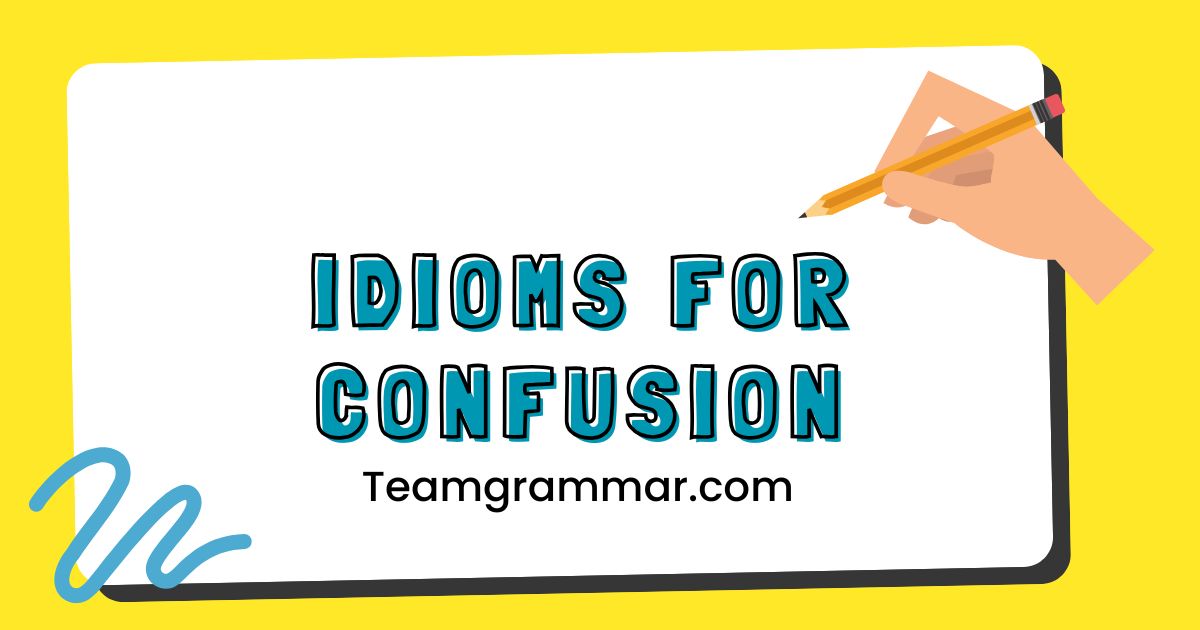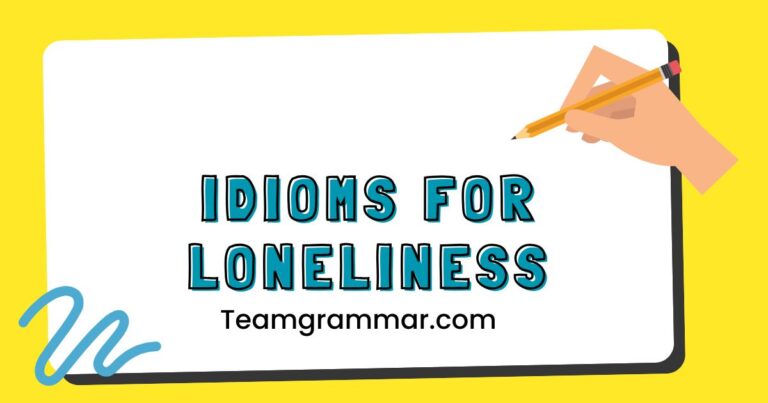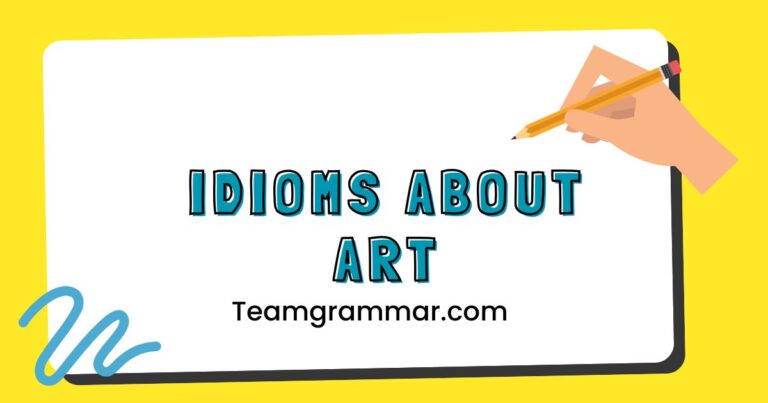38+ Idioms for Confusion: Mastering Expressions of Non-Understanding
Understanding idioms is crucial for mastering English, particularly when expressing confusion or a lack of comprehension. Idioms add color and nuance to communication, allowing speakers to convey complex feelings in a concise and relatable way.
This article provides a comprehensive guide to idioms used to indicate non-understanding, exploring their meanings, structures, and usage. It is designed for English language learners of all levels, from beginners to advanced speakers, who wish to enhance their expressive abilities and gain a deeper understanding of idiomatic English.
Table of Contents
- Introduction
- Definition of Idioms for Not Understanding
- Structural Breakdown of Idioms
- Types and Categories of Idioms for Not Understanding
- Examples of Idioms for Not Understanding
- Usage Rules for Idioms
- Common Mistakes When Using Idioms
- Practice Exercises
- Advanced Topics in Idiomatic Usage
- Frequently Asked Questions (FAQ)
- Conclusion
Introduction
Idioms are an essential part of the English language, adding depth and color to everyday conversations. They are especially useful when expressing nuanced emotions or states of mind, such as confusion or a lack of understanding.
Mastering these idioms not only improves comprehension but also enhances expressive abilities, allowing you to communicate more effectively and naturally. This article delves into the world of idioms that specifically convey non-understanding, providing a comprehensive guide to their meanings, usage, and common pitfalls.
By understanding these idioms, learners can navigate complex conversations with greater confidence and precision.
This guide is designed to benefit English language learners at all proficiency levels. Whether you are a beginner struggling to grasp basic expressions or an advanced speaker aiming to refine your idiomatic usage, this article offers valuable insights and practical examples.
By mastering idioms related to confusion, you’ll be able to better express yourself and understand native speakers in a variety of contexts. Furthermore, understanding these idioms provides a window into the cultural nuances embedded within the English language, enhancing your overall linguistic competence.
Definition of Idioms for Not Understanding
An idiom is a phrase or expression whose meaning cannot be understood from the ordinary meanings of the words it contains. Instead, idioms have a figurative meaning that is culturally specific.
Idioms for not understanding are phrases used to express confusion, incomprehension, or a lack of knowledge about something. These idioms are crucial for conveying subtle shades of meaning beyond simple statements like “I don’t understand.”
These idioms can be classified based on their function: to express mild confusion, utter bewilderment, or difficulty grasping a concept. They provide a more colorful and engaging way to communicate than simply stating “I don’t get it.” For example, saying “It’s all Greek to me” immediately conveys a sense of complete incomprehension in a more vivid manner.
The context in which these idioms are used is crucial; understanding the situation and the speaker’s intent is key to interpreting the idiom correctly.
Structural Breakdown of Idioms
The structure of idioms can vary significantly, ranging from simple phrases to more complex clauses. Some idioms maintain a relatively fixed structure, while others allow for slight variations depending on the context.
Understanding the structural elements of idioms can help learners recognize and use them more effectively.
Many idioms consist of a verb and a preposition (e.g., “miss the point”). Others involve nouns and adjectives forming a descriptive phrase (e.g., “a fog”).
Some idioms are complete sentences (e.g., “Did I miss something?”). The key is that the meaning of the entire phrase is different from the literal meaning of the individual words.
For example, “to be in the dark” doesn’t literally mean being in a place without light; it means being unaware or uninformed about something. Furthermore, idioms often rely on metaphorical language, using imagery and symbolism to convey abstract concepts.
This reliance on figurative language is what makes idioms both expressive and challenging to learn.
Types and Categories of Idioms for Not Understanding
Idioms for expressing a lack of understanding can be categorized in several ways, based on their literal vs. figurative nature, their grammatical structure, or the degree of confusion they express. Here, we’ll explore a few key categories:
Literal-Sounding Idioms
These idioms use words that, on the surface, seem to have a literal meaning, but in context, they convey confusion or lack of understanding. They often rely on understatement or irony to express the speaker’s incomprehension.
Figurative Idioms
These are the most common type of idioms, where the meaning is entirely different from the literal interpretation of the words. They often use metaphors, similes, or other figures of speech to convey a sense of bewilderment or lack of knowledge.
Question-Form Idioms
These idioms are phrased as questions, often rhetorical, to express confusion or to seek clarification. They can also imply that the speaker finds something unbelievable or nonsensical.
Examples of Idioms for Not Understanding
This section provides an extensive list of idioms used to express a lack of understanding, categorized by the degree of confusion they convey. Each idiom is accompanied by its meaning and example sentences to illustrate its usage.
General Confusion
These idioms express a mild to moderate level of confusion or a general lack of understanding. They are suitable for situations where the speaker is unsure about something but not completely lost.
The following table presents a series of idioms that express general confusion. Each row provides the idiom, its meaning, and example sentences to illustrate how it’s used in context.
| Idiom | Meaning | Example Sentences |
|---|---|---|
| I’m lost. | I don’t understand. | I’m completely lost. Can you explain that again? |
| I don’t follow. | I can’t understand your reasoning. | I don’t follow your logic at all. Where are you going with this? |
| I’m not sure I get it. | I’m not completely understanding. | I’m not sure I get it. Could you provide another example? |
| That’s not clear to me. | I don’t understand something. | That’s not clear to me. Can you elaborate on the details? |
| I’m a bit hazy on that. | I’m slightly confused about something. | I’m a bit hazy on that. Could you clarify the process? |
| I’m in the dark. | I’m unaware or uninformed. | I’m completely in the dark about the project. What’s happening? |
| It’s all Greek to me. | I can’t understand anything. | This technical jargon is all Greek to me. |
| It’s beyond me. | I’m unable to understand it. | Quantum physics is beyond me. |
| I can’t make head nor tail of it. | I can’t understand it at all. | I can’t make head nor tail of this instruction manual. |
| Is that clear? (often rhetorical) | Do you understand? (often implying they don’t think you do) | He explained the complex theory, then asked, “Is that clear?” |
| Are we on the same page? | Do we have a shared understanding? | Before we proceed, are we all on the same page? |
| What are you getting at? | What are you trying to say? | I don’t understand. What are you getting at? |
| What’s the catch? | What’s the hidden problem? | This deal sounds too good to be true. What’s the catch? |
| Am I missing something? | Is there something I’m not aware of? | Am I missing something? Why is everyone so upset? |
| I’m drawing a blank. | I can’t remember or understand something. | I’m drawing a blank. I have no idea what you’re talking about. |
| I’m not following you. | I don’t understand your train of thought. | I’m not following you. Please explain your reasoning. |
| Could you run that by me again? | Could you repeat that? | That was a lot of information. Could you run that by me again? |
| Say what? | What did you say? (informal) | Say what? I didn’t hear you. |
| Come again? | Please repeat what you said. (informal) | Come again? I didn’t quite catch that. |
| I’m a little slow today. | I’m not understanding things quickly today. | I’m a little slow today. Can you explain it one more time? |
| I’m at a loss. | I don’t know what to think or understand. | I’m at a loss to explain what happened. |
| I’m puzzled. | I’m confused or perplexed. | I’m puzzled by his behavior. |
| I’m scratching my head. | I’m confused and trying to understand. | I’m scratching my head trying to figure out this problem. |
| It doesn’t compute. | I can’t understand or accept it. | His explanation just doesn’t compute. |
Difficulty Understanding
These idioms indicate that the speaker is struggling to understand something, even if they have some basic grasp of the topic. They suggest a more active effort to comprehend, but with limited success.
The following table provides idioms that indicate difficulty in understanding. Each entry includes the idiom, its interpretation, and illustrative example sentences.
| Idiom | Meaning | Example Sentences |
|---|---|---|
| I’m struggling to understand. | I’m finding it difficult to comprehend. | I’m struggling to understand the new software. |
| I’m having a hard time grasping that. | I’m finding it difficult to understand. | I’m having a hard time grasping the concept of relativity. |
| I’m not quite there yet. | I’m not fully understanding yet. | I’m not quite there yet. Can you give me a hint? |
| I’m missing something. | There’s a piece of information I lack. | I’m missing something. Why did they make that decision? |
| I’m having trouble wrapping my head around it. | I’m finding it difficult to comprehend. | I’m having trouble wrapping my head around the new regulations. |
| I can’t quite put my finger on it. | I can’t identify the problem clearly. | I can’t quite put my finger on what’s wrong with this plan. |
| It’s not clicking. | I’m not understanding it. | This math problem is just not clicking for me. |
| I’m going around in circles. | I’m getting nowhere trying to understand. | I’m going around in circles trying to solve this puzzle. |
| I’m beating my head against a wall. | I’m trying hard but failing to understand. | I’m beating my head against a wall trying to learn this programming language. |
| I’m up against a brick wall. | I’m facing an insurmountable obstacle to understanding. | I’m up against a brick wall trying to get this project approved. |
| I’m trying to get my head around it. | I’m trying to understand it. | I’m trying to get my head around the new company policy. |
| I’m wading through mud. | I’m having a difficult time understanding something complex. | I’m wading through mud trying to understand this legal document. |
| I’m lost in the weeds. | I’m overwhelmed by the details and can’t see the big picture. | I’m lost in the weeds of this project. |
| I’m not seeing the forest for the trees. | I’m focusing on the details and missing the overall concept. | I’m not seeing the forest for the trees. Can you summarize the main points? |
| I’m getting bogged down. | I’m getting stuck in the details and losing my understanding. | I’m getting bogged down in the technical specifications. |
| I’m hitting a snag. | I’m encountering an obstacle to understanding. | I’m hitting a snag trying to install this software. |
| I’m running into a roadblock. | I’m encountering a significant obstacle to understanding. | I’m running into a roadblock trying to get this research approved. |
| I’m stumped. | I’m unable to understand or solve something. | I’m stumped. I have no idea how to fix this problem. |
| I’m at a standstill. | I’m unable to proceed because I don’t understand. | I’m at a standstill until I understand these instructions. |
| I’m drawing a blank. | I can’t remember or understand something. (Also in general confusion) | I’m drawing a blank on this topic. |
| The penny hasn’t dropped. | I haven’t understood something yet. (British English) | The penny hasn’t dropped yet. Can you explain it in simpler terms? |
| I’m still piecing it together. | I’m slowly understanding, but not fully. | I’m still piecing it together. I need more information. |
| I’m trying to connect the dots. | I’m trying to understand how things are related. | I’m trying to connect the dots to understand the whole situation. |
Complete Lack of Understanding
These idioms express a total absence of understanding or comprehension. They are used when the speaker is completely baffled or bewildered by something.
The following table presents idioms that express a complete lack of understanding. It includes the idiom, its meaning, and illustrative sentences for context.
| Idiom | Meaning | Example Sentences |
|---|---|---|
| It’s all double Dutch to me. | I understand absolutely nothing. | This legal jargon is all double Dutch to me. |
| It’s beyond my comprehension. | I can’t understand it at all. | The theory of relativity is beyond my comprehension. |
| I have no clue. | I have no idea. | I have no clue what he’s talking about. |
| I haven’t the foggiest idea. | I have absolutely no idea. | I haven’t the foggiest idea where I left my keys. |
| Your guess is as good as mine. | I don’t know any more than you do. | “What’s going on?” “Your guess is as good as mine.” |
| It’s a mystery to me. | I can’t explain it. | Why she left is a mystery to me. |
| I’m completely baffled. | I’m totally confused. | I’m completely baffled by his behavior. |
| I’m totally bewildered. | I’m extremely confused. | I’m totally bewildered by this new technology. |
| I’m at sea. | I’m completely lost and confused. | I’m at sea with these new regulations. |
| I’m out of my depth. | I’m in a situation I can’t handle or understand. | I’m out of my depth in this advanced physics class. |
| I’m in a fog. | I’m confused and disoriented. | I’m in a fog after that long meeting. |
| I’m spaced out. | I’m not paying attention or understanding. (Informal) | I’m spaced out today. I didn’t hear a word you said. |
| I’m not with it. | I’m not alert or understanding. (Informal) | I’m not with it this morning. I need more coffee. |
| I’m not getting through. | I’m unable to understand or communicate effectively. | I’m not getting through to him. He just doesn’t understand. |
| I’m banging my head against a brick wall. | I’m trying hard but achieving nothing. (Similar to “beating my head…”) | I’m banging my head against a brick wall trying to fix this computer. |
| I’m getting nowhere. | I’m making no progress in understanding. | I’m getting nowhere trying to learn this language. |
| It’s like talking to a brick wall. | The person is not understanding or responding. | Trying to explain this to him is like talking to a brick wall. |
| It’s like water off a duck’s back. | It has no effect on the person. | Criticism is like water off a duck’s back to her. |
| I’m drawing a complete blank. | I can’t remember or understand anything at all. | I’m drawing a complete blank on this subject. |
| I’m totally blanking. | I can’t remember or understand anything. (Informal) | I’m totally blanking on his name. |
Usage Rules for Idioms
Using idioms correctly requires understanding their specific context and nuances. While idioms can add color to your speech, using them inappropriately can lead to confusion or miscommunication.
Here are some key rules to keep in mind:
- Context is crucial: Always consider the situation and your audience when using idioms. Some idioms are informal and may not be suitable for formal settings.
- Meaning: Be sure you fully understand the meaning of the idiom before using it. Misusing an idiom can be embarrassing or confusing.
- Grammar: Pay attention to the grammatical structure of the idiom. Some idioms have a fixed structure and cannot be altered.
- Overuse: Avoid overusing idioms, as this can make your speech sound unnatural or contrived.
- Cultural Sensitivity: Be aware that some idioms may be culturally specific and not easily understood by people from different backgrounds.
Furthermore, it’s important to note that some idioms have variations depending on the region or dialect. For example, an idiom common in British English may not be widely used or understood in American English.
Therefore, it’s essential to be aware of these regional differences to avoid confusion. Additionally, some idioms may have multiple meanings or interpretations, so it’s crucial to consider the context to determine the intended meaning.
Common Mistakes When Using Idioms
Even advanced English learners sometimes make mistakes when using idioms. Here are some common errors to avoid:
- Literal Interpretation: The most common mistake is interpreting an idiom literally, which can lead to nonsensical statements. For example, understanding “It’s raining cats and dogs” to mean that animals are falling from the sky.
- Incorrect Word Choice: Using the wrong words within an idiom can change its meaning or make it incomprehensible. For example, saying “I’m drawing a blue” instead of “I’m drawing a blank.”
- Grammatical Errors: Altering the grammatical structure of an idiom can also change its meaning. For example, saying “Head nor tail I can’t make” instead of “I can’t make head nor tail of it.”
The table below illustrates some common mistakes made when using idioms for not understanding, along with the correct usage.
| Incorrect | Correct | Explanation |
|---|---|---|
| I’m drawing a blue. | I’m drawing a blank. | “Drawing a blank” means you can’t remember or understand something. |
| It’s all Greek for me. | It’s all Greek to me. | The correct idiom is “It’s all Greek to me,” meaning it’s incomprehensible. |
| I can’t do head or tail of it. | I can’t make head nor tail of it. | The correct idiom is “I can’t make head nor tail of it,” meaning you can’t understand it at all. |
| I’m in the darkness. | I’m in the dark. | The correct idiom is “I’m in the dark,” meaning you’re unaware or uninformed. |
| I’m losing. | I’m lost. | While “losing” can mean being defeated, “lost” is the correct idiom for not understanding. |
| The penny has dropped for me. | The penny has dropped. | The correct idiom is “The penny has dropped,” meaning you’ve finally understood something. |
| I’m not with you. | I’m not following you. | Both can work, but “I’m not following you” is more specific to understanding an argument or explanation. “I’m not with you” can also imply disagreement. |
Practice Exercises
These exercises will help you practice using idioms for not understanding. Each exercise focuses on different aspects of idiomatic usage, from identifying the correct idiom to using it in context.
Exercise 1: Multiple Choice
Choose the best idiom to complete each sentence.
| Question | Options | Answer |
|---|---|---|
| 1. I tried to understand the lecture, but it was all ________ to me. | a) English b) French c) Greek d) Spanish | c) Greek |
| 2. I ________ when he started talking about quantum physics. | a) got lost b) got found c) got happy d) got angry | a) got lost |
| 3. I have ________ what you’re trying to say. Can you explain it again? | a) a clue b) no clue c) many clues d) some clues | b) no clue |
| 4. I’m ________ trying to understand this instruction manual. | a) head over heels b) beating my head against a wall c) on top of the world d) under the weather | b) beating my head against a wall |
| 5. The new company policy is ________. I can’t make sense of it. | a) crystal clear b) a walk in the park c) double Dutch d) a piece of cake | c) double Dutch |
| 6. “Are you following me?” “No, I’m ________. Can you go back a step?” | a) on the ball b) in the know c) in the dark d) ahead of the game | c) in the dark |
| 7. I’m ________ to explain why the computer crashed. | a) at a loss b) at a gain c) at a party d) at sea | a) at a loss |
| 8. After the complicated explanation, he asked, “_________?” | a) Is that confusing? b) Is that difficult? c) Are we on the same page? d) Are we finished? | c) Are we on the same page? |
| 9. I’m ________ trying to connect all the information. | a) skipping rope b) jumping for joy c) connecting the dots d) painting the town red | c) connecting the dots |
| 10. I’m ________. I don’t understand why everyone is upset. | a) missing the boat b) missing the point c) missing something d) missing the target | c) missing something |
Exercise 2: Fill in the Blanks
Fill in the blanks with the correct idiom from the list below.
(List: *drawing a blank, beyond me, not following, come again, what’s the catch*, *at sea*, *hitting a snag*, *getting nowhere*, *penny hasn’t dropped*, *baffled*)
| Question | Answer |
|---|---|
| 1. I’m completely ________ by his sudden change in attitude. | baffled |
| 2. I’m ________ trying to fix this computer. I think I need professional help. | getting nowhere |
| 3. I’m ________ with this new software. It’s so complicated! | at sea |
| 4. The ________ yet; can you explain it again more simply? | penny hasn’t dropped |
| 5. ________? I didn’t hear what you said. | Come again |
| 6. I’m ________ you. What are you trying to say? | not following |
| 7. This is ________. I can’t understand it at all. | beyond me |
| 8. I’m ________ on his name. I can’t remember it at all. | drawing a blank |
| 9. I’m ________ trying to install this program. It keeps giving me an error message. | hitting a snag |
| 10. This offer sounds too good to be true. ________? | What’s the catch |
Exercise 3: Sentence Completion
Complete each sentence with an appropriate idiom to express a lack of understanding.
| Question | Answer |
|---|---|
| 1. I tried to read the research paper, but it was _____________________. | like wading through mud. |
| 2. When the teacher started explaining the formula, I felt like I was _____________________. | lost in the weeds. |
| 3. I’m trying to understand this new policy, but _____________________. | I’m beating my head against a wall. |
| 4. He started talking about the stock market, and I was completely _____________________. | out of my depth. |
| 5. I’ve read the instructions several times, but _____________________. | it’s not clicking. |
| 6. When she started using technical jargon, it was _____________________. | all double Dutch to me. |
| 7. I’ve been trying to fix this problem all day, but _____________________. | I’m getting nowhere. |
| 8. I’ve asked him to explain it several times, but it’s like _____________________. | talking to a brick wall. |
| 9. I can’t remember where I parked the car; I’m _____________________. | drawing a complete blank. |
| 10. I’m trying to understand his decision, but _____________________. | it doesn’t compute. |
Advanced Topics in Idiomatic Usage
For advanced learners, understanding the nuances of idiomatic usage involves more than just memorizing phrases. It requires an awareness of regional variations, historical context, and the subtle differences in meaning that can arise depending on the situation.
Regional Variations
Idioms can vary significantly depending on the region. What is a common expression in one part of the English-speaking world may be completely unknown in another.
For example, the phrase “the penny dropped,” meaning “I finally understood,” is more common in British English than in American English. Similarly, some idioms may have different connotations or levels of formality depending on the region.
Historical Context
Many idioms have historical roots that provide insight into their meaning and usage. Understanding the origin of an idiom can help learners appreciate its cultural significance and use it more appropriately.
For example, the idiom “raining cats and dogs” is believed to have originated in 16th-century England, when thatch roofs would become slippery during heavy rain, causing animals to fall off.
Frequently Asked Questions (FAQ)
Here are some frequently asked questions about idioms for not understanding:
- What is the difference between an idiom and a saying?
An idiom is a phrase whose meaning is not deducible from the literal meanings of its words, while a saying is a well-known statement that expresses a general truth or belief. Some idioms can also be sayings, but not all sayings are idioms.
- How can I improve my understanding of idioms?
Reading widely, listening to native speakers, and paying attention to context are all effective ways to improve your understanding of idioms. Creating flashcards, keeping a vocabulary journal, and practicing using idioms in conversation can also be helpful.
- Are idioms the same in all English-speaking countries?
No, idioms can vary significantly depending on the region or dialect. What is a common expression in one country may be completely unknown in another. It’s important to be aware of these regional differences to avoid confusion.
- Is it okay to use idioms in formal writing?
In general, it’s best to avoid using idioms in formal writing, as they can sound informal or colloquial. However, there may be exceptions depending on the specific context and audience. When in doubt, it’s better to err on the side of caution and use more direct and literal language.
- How do I know when to use an idiom?
Use idioms when you want to add color and nuance to your speech or writing. However, be sure to consider the context and your audience. If you’re not sure whether an idiom is appropriate, it’s best to avoid using it.
- What should I do if I don’t understand an idiom?
Ask for clarification. Don’t be afraid to ask the speaker to explain the idiom or provide more context. You can also look up the idiom in a dictionary or online resource.
- Can I create my own idioms?
While it’s possible to create new expressions, they won’t be considered idioms unless they become widely used and accepted by native speakers. Idioms are typically established phrases with a history and cultural significance.
- How can I avoid misusing idioms?
Pay attention to the context, understand the meaning, and be aware of the grammatical structure. Practice using idioms in conversation and get feedback from native speakers. When in doubt, it’s better to use more direct and literal language.
- Are there any online resources for learning idioms?
Yes, there are many online dictionaries, websites, and apps dedicated to idioms. These resources can provide definitions, examples, and practice exercises to help you improve your understanding of idiomatic language.
- Why is it important to learn idioms?
Learning idioms is important because they are an essential part of the English language. Understanding idioms will help you communicate more effectively, understand native speakers, and gain a deeper appreciation of the English language and culture.
Conclusion
Mastering idioms for expressing non-understanding is a valuable skill for any English language learner. These expressions add depth and nuance to communication, allowing you to convey confusion and incomprehension in a more engaging and relatable way.
By understanding the different types of idioms, their usage rules, and common mistakes to avoid, you can enhance your expressive abilities and communicate more effectively in a variety of contexts.
Remember to practice using idioms in conversation, read widely to expand your vocabulary, and be aware of regional variations. With consistent effort and attention to detail, you can master the art of idiomatic expression and take your English language skills
to the next level.
Keep exploring and embracing the richness of the English language!







